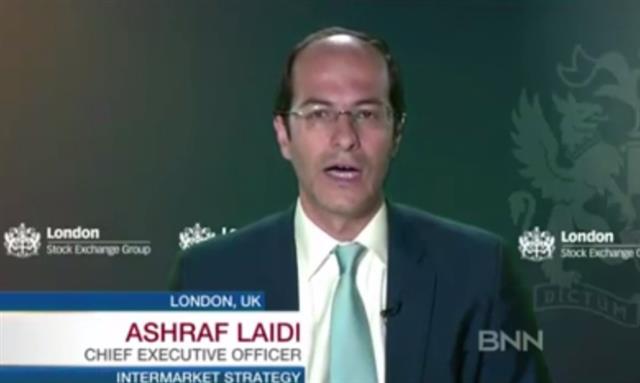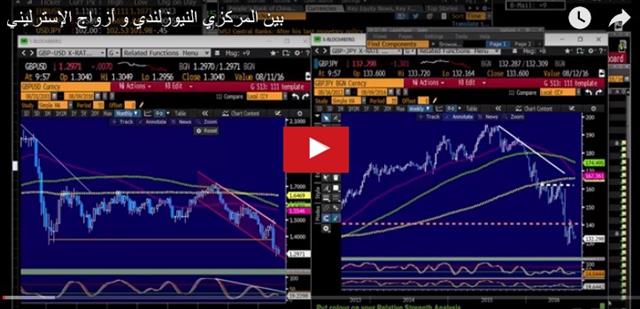Intraday Market Thoughts Archives
Displaying results for week of Aug 07, 2016الفرق بين الحساب الجاري والميزان التجاري
Lessons From the RBNZ
The New Zealand rate cut led to a brutal reversal in NZD/USD that later faded; we look at what the wild price swings mean. The Canadian dollar was the top performer Thursday while the yen lagged. Chinese retail sales and industrial production data is due later. US retail sales are due Friday. The 2nd NZD trade issued in the Premium Insights has been filled.
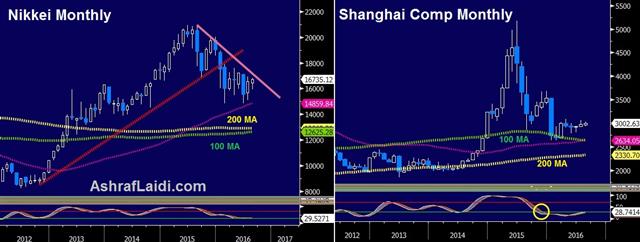
The kiwi momentarily fell after the RBNZ rate cut then surged more than 150 pips because of a 50 bps cut or the lack of clear dovish commentary. However, as the day wore on, all the gains faded and NZD/USD finished the day virtually unchanged. Part of the subsequent decline was due because the RBNZ later said markets missed the downside risks in its monetary policy statement.
For many, the takeaway is confusion and (for once) that might be the right interpretation. Markets and central banks are reforming their relationship at the moment. For most of the past 30 years, trading central banks was binary in developed markets: rates went higher or lower. Central banking was a lever.
Markets have screamed throughout 2016 that the relationship is now much more complicated. The FX move – sometimes even the initial one – depends more on if the market believes the central bank made the right move and oftentimes why the cut is critical. Negative rate moves have backfired and markets are challenging central banks believed to be out of ammunition. Jawboning is ineffective and credibility at all central banks is strained.
Ultimately, interest rates remain an incredibly powerful tool but we may need to build in more space for volatility – especially at this time of year.
We also need to remain attuned to tail risks. Thursday was the anniversary of the yuan drop that roiled markets last year. China will inevitably be a source of instability again and there's an edge in watching more closely. At the moment, economic data is solid but lending is a likely source of problems.
Today, the focus is on factories and consumers. At 0200 GMT, Chinese industrial production for July is due and expected up 6.2% y/y. At the same time, retail sales are forecast to rose 10.5% y/y.
Even a 1 percentage point miss won't roil markets on Friday but it could be a sign of trouble to come.
| Act | Exp | Prev | GMT |
|---|---|---|---|
| Core Retail Sales (m/m) | |||
| 0.2% | 0.7% | Aug 12 12:30 | |
| Retail Sales (q/q) | |||
| 2.3% | 1.0% | 1.0% | Aug 11 22:45 |
| Industrial Production (y/y) | |||
| 6.2% | 6.2% | Aug 12 2:00 | |
RBNZ Cuts, RBA Looks on
As the RBNZ delivered its widely anticipated 25-bp rate cut to 2.00%, NZD made the “expected” jump, before settling lower following dovish comments from RBNZ governor Wheeler.By asserting its concern with sustainable decline in inflation and greater than expected moderation in wage growth, the RBNZ has explicitly opened the door for additional easing in the coming months. As the statement failed to lower the value of the currency, Wheeler cleared the air by stating “we want to see the currency fall” as the cat-&-mouse game with the RBA continues with both central banks wanting to avoid excessive appreciation in their currencies.
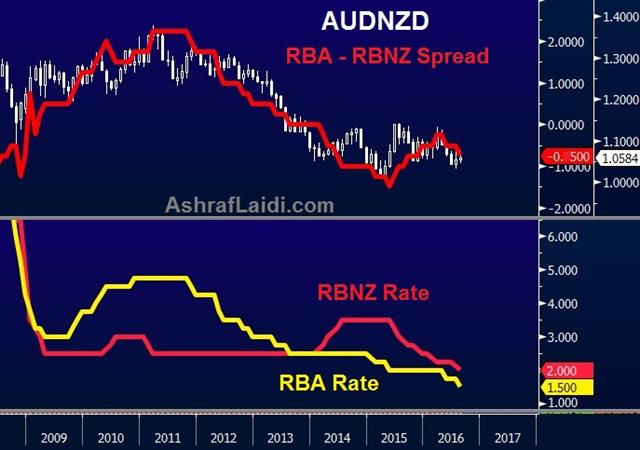
Both the NZD and AUD have proven risen markedly to the frustation of policy makers due to: i) stabilisation in commodities and China market metrics; and 2) Fed keeping rates unchanged. A rate cut of at least 25-bps this year from of the two each central bank is a foregone conclusion in the event of no Fed hike this year, while the macro dynamics as well as market sentiment in China will be instrumental in gauging the moves from the RBA. Another reason the RBNZ has little choice but to cut some more is the planned macro-prudential measures set for September by the RBNZ, aimed at slowing speculative interest in the hot housing market. Such move would remove a crucial obstacle to interest rate cuts and will keep the RBA-RBNZ battle for the lowers well alive.
Ahead of this evening's RBNZ move, we issued a tactical NZD trade in addition to the AUDNZD existing long.
Ashraf on BNN Earlier Today
Ashraf discusses the BoE's failed purchases, UK fundamentals and GBP. Watch.
Questioning QE Physics
The intellectual foundation of central banking boils down to a simple idea: If interest rates are lower, people will borrow and spend more. We know that's largely true but it may not be entirely true and what it means could have a profound effect on the future of markets. In the Premium Insights, the short DAX trade was allowed to be stopped out, leaving 1 other index trade open, 2 in metals and 4 in FX.
Markets have settled into a bit of an August/Olympic malaise but we will remain on guard for the type of event that jarred markets last August. The theme Tuesday was US dollar weakness as some of the post non-farm payrolls enthusiasm faded, partly because of a very weak productivity report.
A development that didn't get the attention it warranted was the failure of the BoE to meet Tuesday's target of 1.17 billion pounds of purchases, coming 50 million pounds short. Just two days into the new QE program, the failure highlights a lack of easily-accessible QE supply. It's a theme that will be a major preoccupation of the BOJ, ECB and BOE in the year ahead.
More broadly, it may be time to question the limits of monetary policy. Perhaps, like physics, the rules of central banking begin to break down in extreme conditions. With rates at zero, or below zero, maybe consumers and companies begin to do the reverse of what the textbooks say. At some level, it makes for consumers to attempt to save more given expected returns for retirement savings are in the low single digits. Meanwhile, companies can use low rates to issue debt and buyback shares.
The market is telling us something. It hasn't rewarded the latest steps into extraordinary monetary policy from the BoJ, ECB and SNB the way the leaders of those central banks expected. That's likely to be a sign of what's to come. What could truly be a paradigm shift is if central banks admit and accept that they are out of ammunition.
From a career perspective, that would be a dangerous move from a central bank leader. The good news is that it would put the onus and focus back on governments to take action and, ultimately, some type of along those lines is inevitable. The question is whether it happens before or after large-scale debt monetization and currency wars. With Gilt rates hitting 0.58% Tuesday, the BOE failing to find bonds to buy and still almost no one questioning the wisdom of central bank orthodoxy, the answer is clear.
Gilt-Bund Spread & GBP Newsflow
GBP traders continue selling rallies as the bad news see no end. Britain's merchandise trade deficit soared to £12.5bn in June, the highest since March 2015 as rising imports grew twice as much as exports. The widening deficit will play a role in dragging down Q2 GDP to contraction territory. The UK's National Institute of Economic and Social Research said UK GDP contracted by 0.2% in July, dragging GDP to 0.3% in the three months ending in July, compared with 0.6% in Q2. The July estimate is the first full month's figure after the Brexit vote. The NIESR sees a 50% chance of a recession by the end of 2017, while warning that its monthly data are volatile and there should not be too much emphasis on developments of a single month.
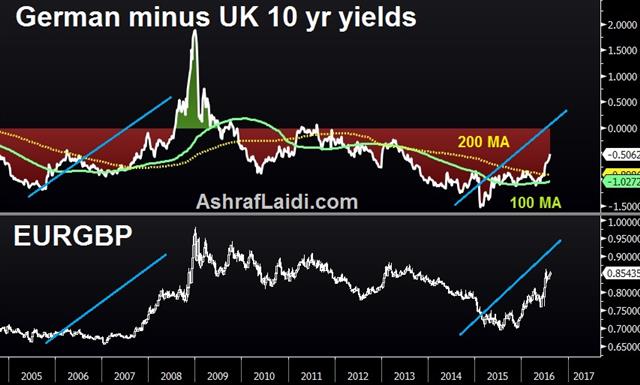
The pound's selloff began early Tuesday when Bank of England policy maker Ian McCafferty –known for his hawkishness—told The Times newspaper that further interest rate cuts and QE may be required. Notably, McCafferty voted for a 25-bp rate hike as early as January. For a policy maker to make such a change underlines the ongoing deterioration in GBP sentiment, from macro and market metric perspectives.
Falling gilt yields can be seen via the prism of yield differentials, which remain a big force in weighing on the currency. The above charts illustrate that 10-year gilt yield advantage over bund yields is at its worst level in over 3-years, highlighting the positive correlation between the German-UK spread and EURGBP cross rate. Expectations of further BoE easing could send the gilt-bund spread to positive for the first time in 5 years. Our Premium trades currently have 1 trade in GBP and one in EUR.
Nth American Divergence, Euro Shorts Retreat
The divergent employment fortunes in Canada and the US on Friday highlighted the ongoing breakout in USD/CAD. Last week, the Australian dollar was the top performer while the pound sterling lagged once again. Chinese trade balance is due next. On Friday, the GBPJPY short was closed at 132.50 from the 135.10 entry, for 260-pt gain. Another GBP trade remains currently in the green.
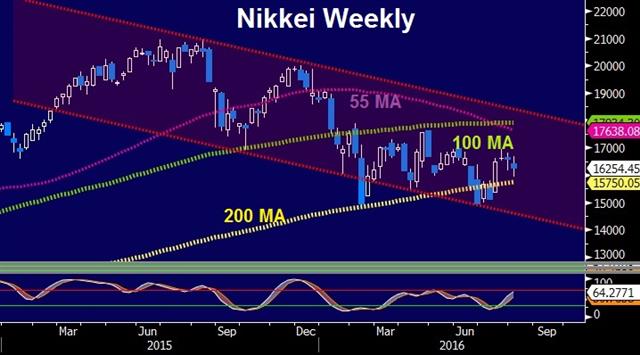
Failing commodity fortunes are a growing headwind in Canada as the country shed 71K full time jobs in July at the same time as the US added 255K overall jobs in the non-farm payrolls report. With oil treading around $40 and signs of oversupply the case for USD/CAD longs is solid. Add in the 15% surprise tax on BC foreign home buyers and one of the few sources of support for CAD is in jeopardy.
Technically, USD/CAD jumped on Friday and is 80 pips from the July high of 1.3253. That will be a level to watch in the week ahead.
But first, to kick off the week is the Japanese current account report at 2350 GMT. The consensus is for a 1.057 trillion yen surplus. The report isn't generally a market mover but all data is taking on heightened importance at the moment with the BOJ preparing to act.
The top event to watch of the day is at 0300 GMT when China releases trade balance data. A $47.6B surplus is expected but the spots to watch are the year-over-year changes in imports and exports. The consensus estimates are for a 3.0% contraction in exports and a 7.0% decline in imports. Neither are great signs up it will take a 1-2 percentage point miss to cause ripples in markets.
Also on China, data on foreign currency reserves showed a continued stabilization near $3.2 trillion. It was a bumpy month for the yuan but it appears as though officials were able to defend levels near 6.7 without expending significant ammunition.
Commitments of Traders
Speculative net futures trader positions as of the close on Tuesday. Net short denoted by - long by +.
EUR -104K vs -112K prior JPY +41.7K vs +34K prior GBP -83K vs -81K prior CHF -1.7K vs +1K prior AUD +31K vs +31K prior CAD +18K vs +23K prior NZD +0.2K vs +0.2K prior
Euro shorts scaled back from a near-extreme level but that only helped to leave fuel on the sidelines for the declines on Thursday and Friday. Yen longs built after the Bank of Japan punt.





